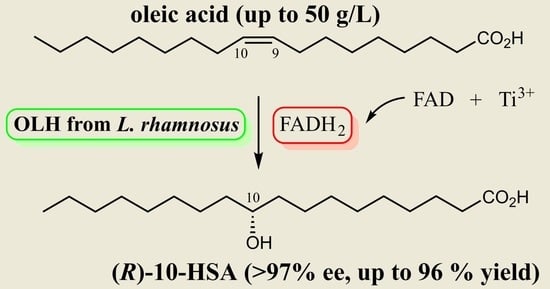Oleate Hydratase from Lactobacillus rhamnosus ATCC 53103: A FADH2-Dependent Enzyme with Remarkable Industrial Potential
Abstract
1. Introduction
2. Results and Discussion
3. Materials and Methods
3.1. Materials and General Methods
3.2. Microorganisms and Growth Media
3.3. Protein Expression and Purification of Oleate Hydratase (OLH)
3.4. Protein Expression and Purification of Glucose Dehydrogenase (GDH)
3.5. Oleic Acid Hydration Experiments
3.5.1. Evaluation of the OLH Activity with Different Enzyme Preparations and in Presence of FAD (Table 1)
3.5.2. Evaluation of the OLH Activity in Presence of Enzymatically Generated NADH, NADPH and FADH2 (Table 2)
3.5.3. Evaluation of the OLH Activity in Presence of Reducing Agents and with or without Addition of FAD (Table 3)
3.6. Analytical Methods and Characterization of the Products Deriving from the Biotransformation Experiments
Instruments and Analytic Condition
3.7. Preparative Synthesis of (R)-10-Hydroxystearic Acid
Supplementary Materials
Author Contributions
Funding
Data Availability Statement
Conflicts of Interest
References
- Kim, K.-R.; Oh, D.-K. Production of hydroxy fatty acids by microbial fatty acid-hydroxylation enzymes. Biotechnol. Adv. 2013, 31, 1473–1485. [Google Scholar] [CrossRef]
- Cao, Y.; Zhang, X. Production of long-chain hydroxy fatty acids by microbial conversion. Appl. Microbiol. Biotechnol. 2013, 97, 3323–3331. [Google Scholar] [CrossRef] [PubMed]
- Lu, W.; Ness, J.E.; Xie, W.; Zhang, X.; Minshull, J.; Gross, R.A. Biosynthesis of Monomers for Plastics from Renewable Oils. J. Am. Chem. Soc. 2010, 132, 15451–15455. [Google Scholar] [CrossRef] [PubMed]
- Serra, S.; Fuganti, C.; Brenna, M.E. Biocatalytic preparation of natural flavours and fragrances. Trends Biotechnol. 2005, 23, 193–198. [Google Scholar] [CrossRef] [PubMed]
- Jo, Y.-S.; An, J.-U.; Oh, D.-K. γ-Dodecelactone Production from Safflower Oil via 10-Hydroxy-12(Z)-octadecenoic Acid Intermediate by Whole Cells of Candida boidinii and Stenotrophomonas nitritireducens. J. Agric. Food Chem. 2014, 62, 6736–6745. [Google Scholar] [CrossRef]
- Wallen, L.; Benedict, R.; Jackson, R. The microbiological production of 10-Hydroxystearic acid from oleic acid. Arch. Biochem. Biophys. 1962, 99, 249–253. [Google Scholar] [CrossRef]
- Davis, E.N.; Wallen, L.L.; Goodwin, J.C.; Rohwedder, W.K.; Rhodes, R.A. Microbial hydration of cis-9-alkenoic acids. Lipids 1969, 4, 356–362. [Google Scholar] [CrossRef]
- Seo, C.W.; Yamada, Y.; Takada, N.; Okada, H. Hydration of Squalene and Oleic Acid by Corynebacterium sp. S-401. Agric. Biol. Chem. 1981, 45, 2025–2030. [Google Scholar] [CrossRef]
- Sakata, K.; Takizawa, N.; Sankawa, U.; Ebizuka, Y.; Noguchi, H. Studies on changes of corn components in silage fermentation. Part VIII. Identification of 10-hydroxy-12Z-octadecenoic and 10-hydroxy-12Z,15Z-octadecadienoic acids in corn silage. Agric. Biol. Chem. 1986, 50, 1077–1079. [Google Scholar] [CrossRef][Green Version]
- Koritala, S.; Hou, C.; Hesseltine, C.; Bagby, M. Microbial conversion of oleic acid to 10-hydroxystearic acid. Appl. Microbiol. Biotechnol. 1989, 32, 299–304. [Google Scholar] [CrossRef]
- El-Sharkawy, S.H.; Yang, W.; Dostal, L.; Rosazza, J.P. Microbial oxidation of oleic acid. Appl. Environ. Microbiol. 1992, 58, 2116–2122. [Google Scholar] [CrossRef]
- Koritala, S.; Bagby, M.O. Microbial conversion of linoleic and linolenic acids to unsaturated hydroxy fatty acids. J. Am. Oil Chem. Soc. 1992, 69, 575–578. [Google Scholar] [CrossRef]
- Hou, C.T. Conversion of linoleic acid to 10-hydroxy-12(Z)-octadecenoic acid by Flavobacterium sp. (NRRL B-14859). J. Am. Oil Chem. Soc. 1994, 71, 975–978. [Google Scholar] [CrossRef]
- Kaneshiro, T.; Huang, J.-K.; Weisleder, D.; Bagby, M.O. 10(R)-Hydroxystearic acid production by a novel microbe, NRRL B-14797, isolated from compost. J. Ind. Microbiol. Biotechnol. 1994, 13, 351–355. [Google Scholar] [CrossRef]
- Hudson, J.; MacKenzie, C.A.M.; Joblin, K.N. Conversion of oleic acid to 10-hydroxystearic acid by two species of ruminal bacteria. Appl. Microbiol. Biotechnol. 1995, 44, 1–6. [Google Scholar] [CrossRef] [PubMed]
- Morvan, B.; Joblin, K.N. Hydration of Oleic Acid by Enterococcus gallinarum, Pediococcus acidilactici and Lactobacillus sp. Isolated from the Rumen. Anaerobe 1999, 5, 605–611. [Google Scholar] [CrossRef]
- Kim, M.H.; Park, M.S.; Chung, C.H.; Kim, C.T.; Kim, Y.S.; Kyung, K.H. Conversion of unsaturated food fatty acids into hy-droxy fatty acids by lactic acid bacteria. J. Microbiol. Biotechnol. 2003, 13, 360–365. [Google Scholar]
- Kishimoto, N.; Yamamoto, I.; Toraishi, K.; Yoshioka, S.; Saito, K.; Masuda, H.; Fujita, T. Two distinct pathways for the formation of hydroxy FA from linoleic acid by lactic acid bacteria. Lipids 2003, 38, 1269–1274. [Google Scholar] [CrossRef]
- Kim, B.-N.; Yeom, S.-J.; Oh, D.-K. Conversion of oleic acid to 10-hydroxystearic acid by whole cells of Stenotrophomonas nitritireducens. Biotechnol. Lett. 2011, 33, 993–997. [Google Scholar] [CrossRef]
- Takeuchi, M.; Kishino, S.; Tanabe, K.; Hirata, A.; Park, S.-B.; Shimizu, S.; Ogawa, J. Hydroxy fatty acid production by Pediococcus sp. Eur. J. Lipid Sci. Technol. 2013, 115, 386–393. [Google Scholar] [CrossRef]
- Serra, S.; De Simeis, D. New insights on the baker’s yeast-mediated hydration of oleic acid: The bacterial contaminants of yeast are responsible for the stereoselective formation of (R)-10-hydroxystearic acid. J. Appl. Microbiol. 2018, 124, 719–729. [Google Scholar] [CrossRef] [PubMed]
- Serra, S.; De Simeis, D. Use of Lactobacillus rhamnosus (ATCC 53103) as Whole-Cell Biocatalyst for the Regio- and Stereoselective Hydration of Oleic, Linoleic, and Linolenic Acid. Catalysts 2018, 8, 109. [Google Scholar] [CrossRef]
- Serra, S.; De Simeis, D.; Castagna, A.; Valentino, M. The Fatty-Acid Hydratase Activity of the Most Common Probiotic Microorganisms. Catalysts 2020, 10, 154. [Google Scholar] [CrossRef]
- Bevers, L.E.; Pinkse, M.W.H.; Verhaert, P.D.E.M.; Hagen, W.R. Oleate Hydratase Catalyzes the Hydration of a Nonactivated Carbon-Carbon Bond. J. Bacteriol. 2009, 191, 5010–5012. [Google Scholar] [CrossRef] [PubMed]
- Sun, Q.-F.; Zheng, Y.-C.; Chen, Q.; Xu, J.-H.; Pan, J. Engineering of an oleate hydratase for efficient C10-Functionalization of oleic acid. Biochem. Biophys. Res. Commun. 2020, 537, 64–70. [Google Scholar] [CrossRef]
- Castagna, A.; De Simeis, D.; Ferrandi, E.E.; Marzorati, S.; Monti, D.; Serra, S.; Valentino, M. Recombinant Oleate Hydratase from Lactobacillus rhamnosus ATCC 53103: Enzyme Expression and Design of a Reliable Experimental Procedure for the Stereoselective Hydration of Oleic Acid. Catalysts 2020, 10, 1122. [Google Scholar] [CrossRef]
- Löwe, J.; Gröger, H. Fatty Acid Hydratases: Versatile Catalysts to Access Hydroxy Fatty Acids in Efficient Syntheses of Industrial Interest. Catalysts 2020, 10, 287. [Google Scholar] [CrossRef]
- Busch, H.; Tonin, F.; Alvarenga, N.; Broek, M.V.D.; Lu, S.; Daran, J.-M.; Hanefeld, U.; Hagedoorn, P.-L. Exploring the abundance of oleate hydratases in the genus Rhodococcus—discovery of novel enzymes with complementary substrate scope. Appl. Microbiol. Biotechnol. 2020, 104, 5801–5812. [Google Scholar] [CrossRef]
- Zhang, J.; Bilal, M.; Liu, S.; Zhang, J.; Lu, H.; Luo, H.; Luo, C.; Shi, H.; Iqbal, H.M.N.; Zhao, Y. Sustainable Biotransformation of Oleic Acid to 10-Hydroxystearic Acid by a Recombinant Oleate Hydratase from Lactococcus garvieae. Processes 2019, 7, 326. [Google Scholar] [CrossRef]
- Engleder, M.; Strohmeier, G.A.; Weber, H.; Steinkellner, G.; Leitner, E.; Müller, M.; Mink, D.; Schürmann, M.; Gruber, K.; Pichler, H. Evolving the Promiscuity of Elizabethkingia meningoseptica Oleate Hydratase for the Regio- and Stereoselective Hydration of Oleic Acid Derivatives. Angew. Chem. Int. Ed. 2019, 58, 7480–7484. [Google Scholar] [CrossRef] [PubMed]
- Lorenzen, J.; Driller, R.; Waldow, A.; Qoura, F.; Loll, B.; Brück, T. Rhodococcus erythropolis Oleate Hydratase: A New Member in the Oleate Hydratase Family Tree-Biochemical and Structural Studies. ChemCatChem 2017, 10, 407–414. [Google Scholar] [CrossRef]
- Engleder, M.; Pichler, H. On the current role of hydratases in biocatalysis. Appl. Microbiol. Biotechnol. 2018, 102, 5841–5858. [Google Scholar] [CrossRef]
- Kang, W.-R.; Seo, M.-J.; Shin, K.-C.; Park, J.-B.; Oh, D.-K. Comparison of Biochemical Properties of the Original and Newly Identified Oleate Hydratases from Stenotrophomonas maltophilia. Appl. Environ. Microbiol. 2017, 83, e03351-16. [Google Scholar] [CrossRef]
- Demming, R.M.; Otte, K.B.; Nestl, B.; Hauer, B. Optimized Reaction Conditions Enable the Hydration of Non-natural Substrates by the Oleate Hydratase from Elizabethkingia meningoseptica. ChemCatChem 2017, 9, 758–766. [Google Scholar] [CrossRef]
- Schmid, J.; Steiner, L.; Fademrecht, S.; Pleiss, J.; Otte, K.B.; Hauer, B. Biocatalytic study of novel oleate hydratases. J. Mol. Catal. B Enzym. 2016, 133, S243–S249. [Google Scholar] [CrossRef]
- Hiseni, A.; Arends, I.W.C.E.; Otten, L.G. New Cofactor-Independent Hydration Biocatalysts: Structural, Biochemical, and Biocatalytic Characteristics of Carotenoid and Oleate Hydratases. ChemCatChem 2014, 7, 29–37. [Google Scholar] [CrossRef]
- Jeon, E.-Y.; Lee, J.-H.; Yang, K.-M.; Joo, Y.-C.; Oh, D.-K.; Park, J.-B. Bioprocess engineering to produce 10-hydroxystearic acid from oleic acid by recombinant Escherichia coli expressing the oleate hydratase gene of Stenotrophomonas maltophilia. Process. Biochem. 2012, 47, 941–947. [Google Scholar] [CrossRef]
- Joo, Y.-C.; Jeong, K.-W.; Yeom, S.-J.; Kim, Y.-S.; Kim, Y.; Oh, D.-K. Biochemical characterization and FAD-binding analysis of oleate hydratase from Macrococcus caseolyticus. Biochimie 2012, 94, 907–915. [Google Scholar] [CrossRef]
- Kim, B.-N.; Joo, Y.-C.; Kim, Y.-S.; Kim, K.-R.; Oh, D.-K. Production of 10-hydroxystearic acid from oleic acid and olive oil hydrolyzate by an oleate hydratase from Lysinibacillus fusiformis. Appl. Microbiol. Biotechnol. 2011, 95, 929–937. [Google Scholar] [CrossRef]
- Oh, H.-J.; Shin, K.-C.; Oh, D.-K. Production of 10-hydroxy-12,15(Z,Z)-octadecadienoic acid from α-linolenic acid by permeabilized cells of recombinant Escherichia coli expressing the oleate hydratase gene of Stenotrophomonas maltophilia. Biotechnol. Lett. 2013, 35, 1487–1493. [Google Scholar] [CrossRef]
- Yang, B.; Chen, H.; Song, Y.; Chen, Y.Q.; Zhang, H.; Chen, W. Myosin-cross-reactive antigens from four different lactic acid bacteria are fatty acid hydratases. Biotechnol. Lett. 2012, 35, 75–81. [Google Scholar] [CrossRef]
- Hirata, A.; Kishino, S.; Park, S.-B.; Takeuchi, M.; Kitamura, N.; Ogawa, J. A novel unsaturated fatty acid hydratase toward C16 to C22 fatty acids from Lactobacillus acidophilus. J. Lipid Res. 2015, 56, 1340–1350. [Google Scholar] [CrossRef]
- Oh, H.-J.; Kim, S.-U.; Song, J.-W.; Lee, J.-H.; Kang, W.-R.; Jo, Y.-S.; Kim, K.-R.; Bornscheuer, U.T.; Oh, D.-K.; Park, J.-B. Biotransformation of Linoleic Acid into Hydroxy Fatty Acids and Carboxylic Acids Using a Linoleate Double Bond Hydratase as Key Enzyme. Adv. Synth. Catal. 2015, 357, 408–416. [Google Scholar] [CrossRef]
- Takeuchi, M.; Kishino, S.; Hirata, A.; Park, S.-B.; Kitamura, N.; Ogawa, J. Characterization of the linoleic acid Δ9 hydratase catalyzing the first step of polyunsaturated fatty acid saturation metabolism in Lactobacillus plantarum AKU 1009a. J. Biosci. Bioeng. 2015, 119, 636–641. [Google Scholar] [CrossRef] [PubMed]
- Takeuchi, M.; Kishino, S.; Park, S.-B.; Kitamura, N.; Ogawa, J. Characterization of hydroxy fatty acid dehydrogenase involved in polyunsaturated fatty acid saturation metabolism in Lactobacillus plantarum AKU 1009a. J. Mol. Catal. B Enzym. 2015, 117, 7–12. [Google Scholar] [CrossRef]
- Chen, Y.Y.; Liang, N.Y.; Curtis, J.M.; Gänzle, M.G. Characterization of Linoleate 10-Hydratase of Lactobacillus plantarum and Novel Antifungal Metabolites. Front. Microbiol. 2016, 7, 1561. [Google Scholar] [CrossRef] [PubMed]
- Kang, W.-R.; Seo, M.-J.; Shin, K.-C.; Park, J.-B.; Oh, D.-K. Gene cloning of an efficiency oleate hydratase from Stenotrophomonas nitritireducens for polyunsaturated fatty acids and its application in the conversion of plant oils to 10-hydroxy fatty acids. Biotechnol. Bioeng. 2016, 114, 74–82. [Google Scholar] [CrossRef]
- Engleder, M.; Pavkov-Keller, T.; Emmerstorfer-Augustin, A.; Hromic, A.; Schrempf, S.; Steinkellner, G.; Wriessnegger, T.; Leitner, E.; Strohmeier, G.A.; Kaluzna, I.; et al. Structure-Based Mechanism of Oleate Hydratase from Elizabethkingia meningoseptica. ChemBioChem 2015, 16, 1730–1734. [Google Scholar] [CrossRef]
- Park, A.K.; Lee, G.H.; Kim, D.W.; Jang, E.H.; Kwon, H.T.; Chi, Y.M. Crystal structure of oleate hydratase from Stenotrophomonas sp. KCTC 12332 reveals conformational plasticity surrounding the FAD binding site. Biochem. Biophys. Res. Commun. 2018, 499, 772–776. [Google Scholar] [CrossRef]
- Schwinn, K.; Ferré, N.; Huix-Rotllant, M. UV-visible absorption spectrum of FAD and its reduced forms embedded in a cryptochrome protein. Phys. Chem. Chem. Phys. 2020, 22, 12447–12455. [Google Scholar] [CrossRef]
- Nivière, V.; Fieschi, F.; Décout, J.-L.; Fontecave, M. The NAD(P)H:Flavin Oxidoreductase from Escherichia coli. J. Biol. Chem. 1999, 274, 18252–18260. [Google Scholar] [CrossRef]
- Bechtold, M.; Brenna, M.E.; Femmer, C.; Gatti, F.G.; Panke, S.; Parmeggiani, F.; Sacchetti, A. Biotechnological Development of a Practical Synthesis of Ethyl (S)-2-Ethoxy-3-(p-methoxyphenyl)propanoate (EEHP): Over 100-Fold Productivity Increase from Yeast Whole Cells to Recombinant Isolated Enzymes. Org. Process. Res. Dev. 2011, 16, 269–276. [Google Scholar] [CrossRef]
- Morokutti, A.; Lyskowski, A.; Sollner, S.; Pointner, E.; Fitzpatrick, T.B.; Kratky, C.; Gruber, K.; Macheroux, P. Structure and Function of YcnD from Bacillus subtilis, a Flavin-Containing Oxidoreductase†,‡. Biochemistry 2005, 44, 13724–13733. [Google Scholar] [CrossRef]
- Zehnder, A.J.; Wuhrmann, K. Titanium (III) citrate as a nontoxic oxidation-reduction buffering system for the culture of obligate anaerobes. Science 1976, 194, 1165–1166. [Google Scholar] [CrossRef]
- Unversucht, S.; Hollmann, F.; Schmid, A.; Van Pée, K.-H. FADH2-Dependence of Tryptophan 7-Halogenase. Adv. Synth. Catal. 2005, 347, 1163–1167. [Google Scholar] [CrossRef]
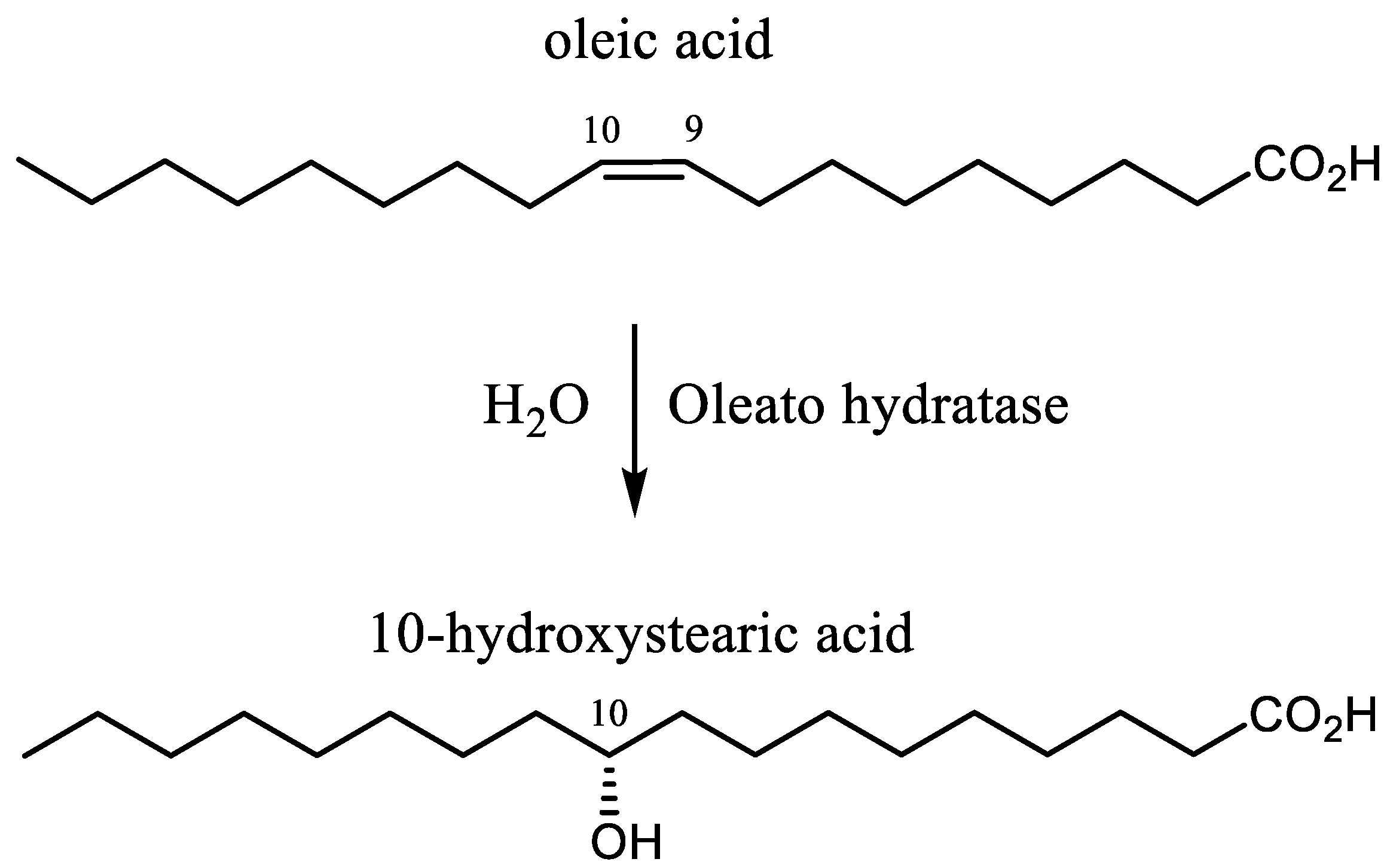
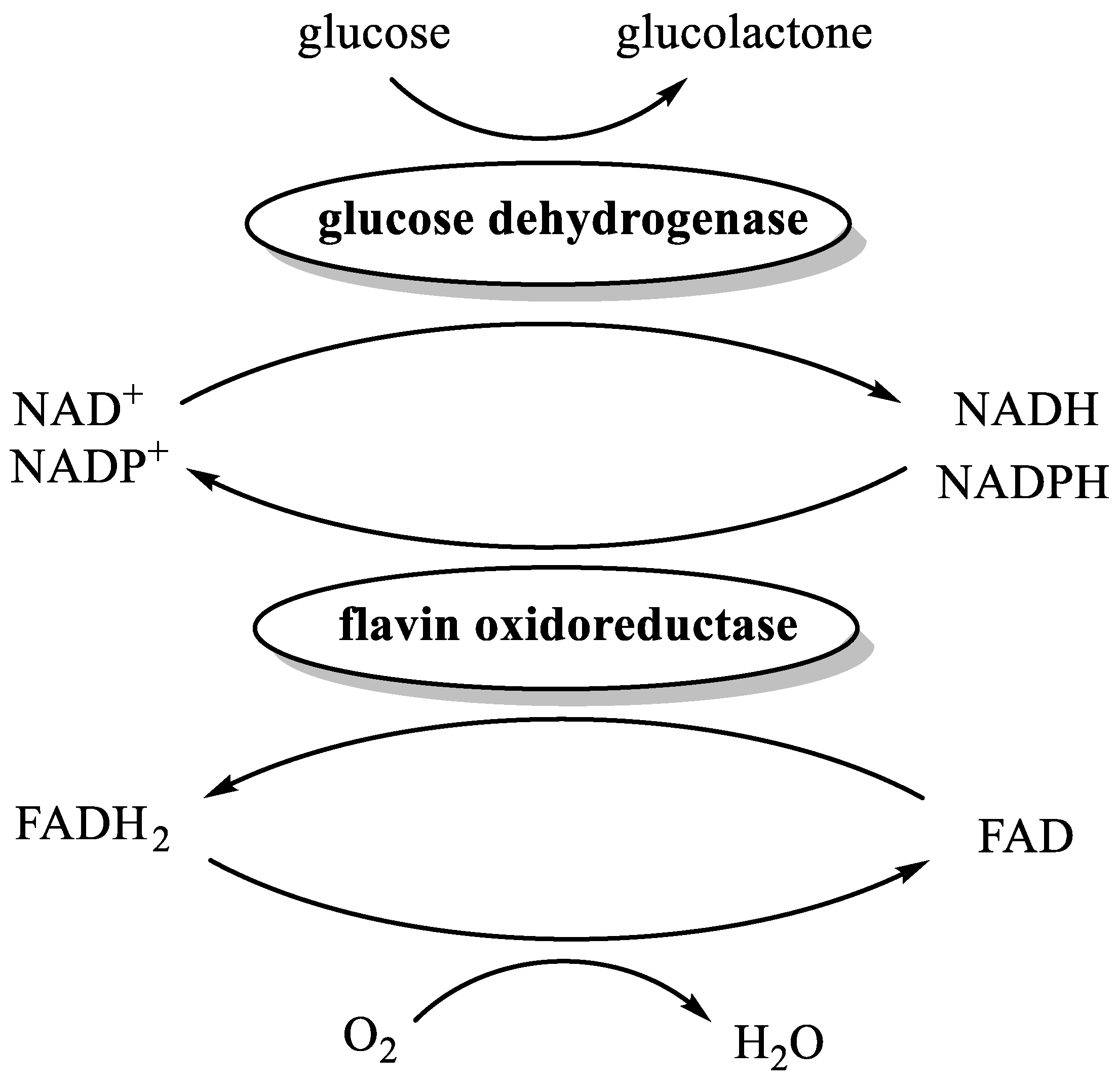
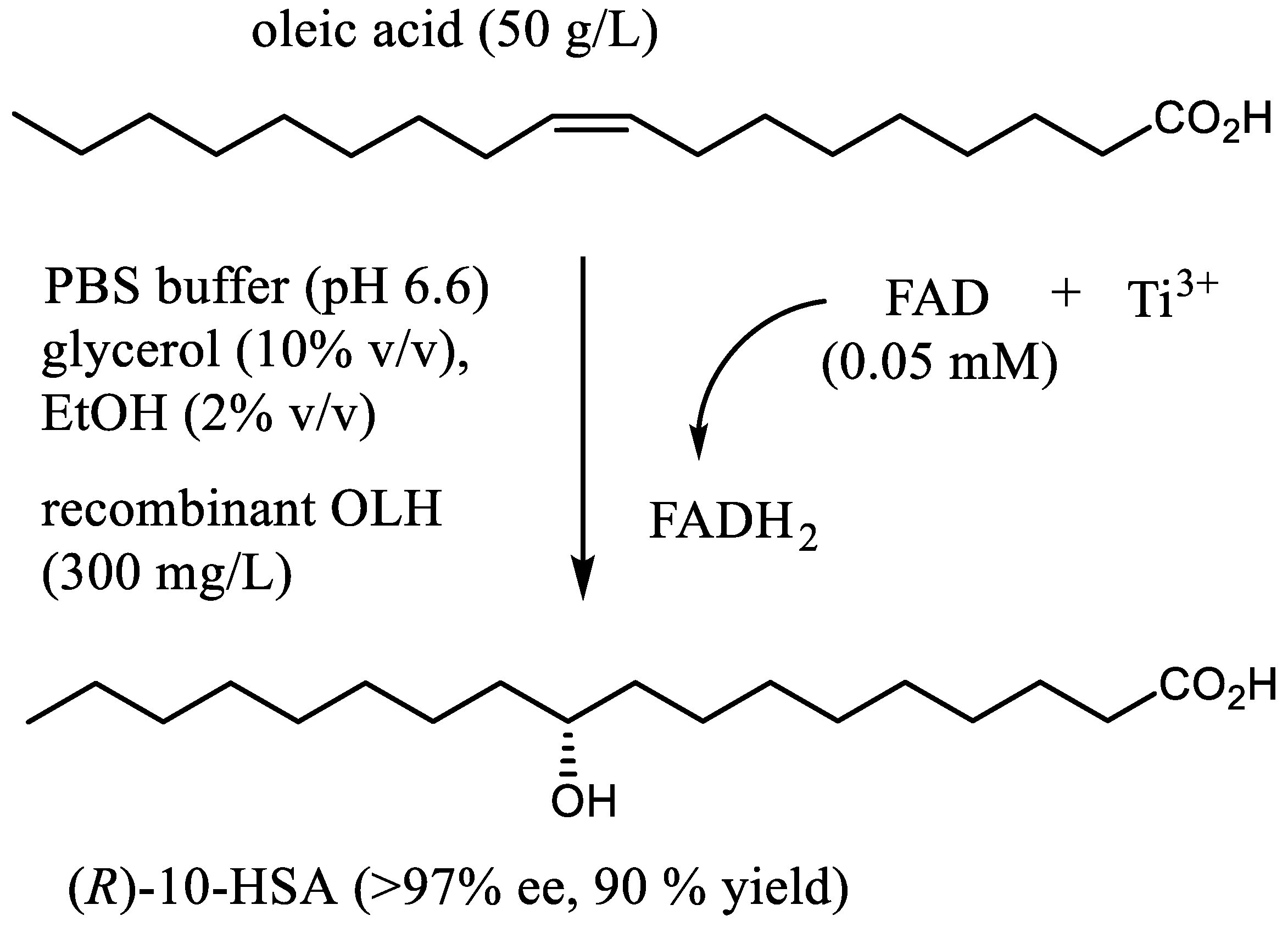
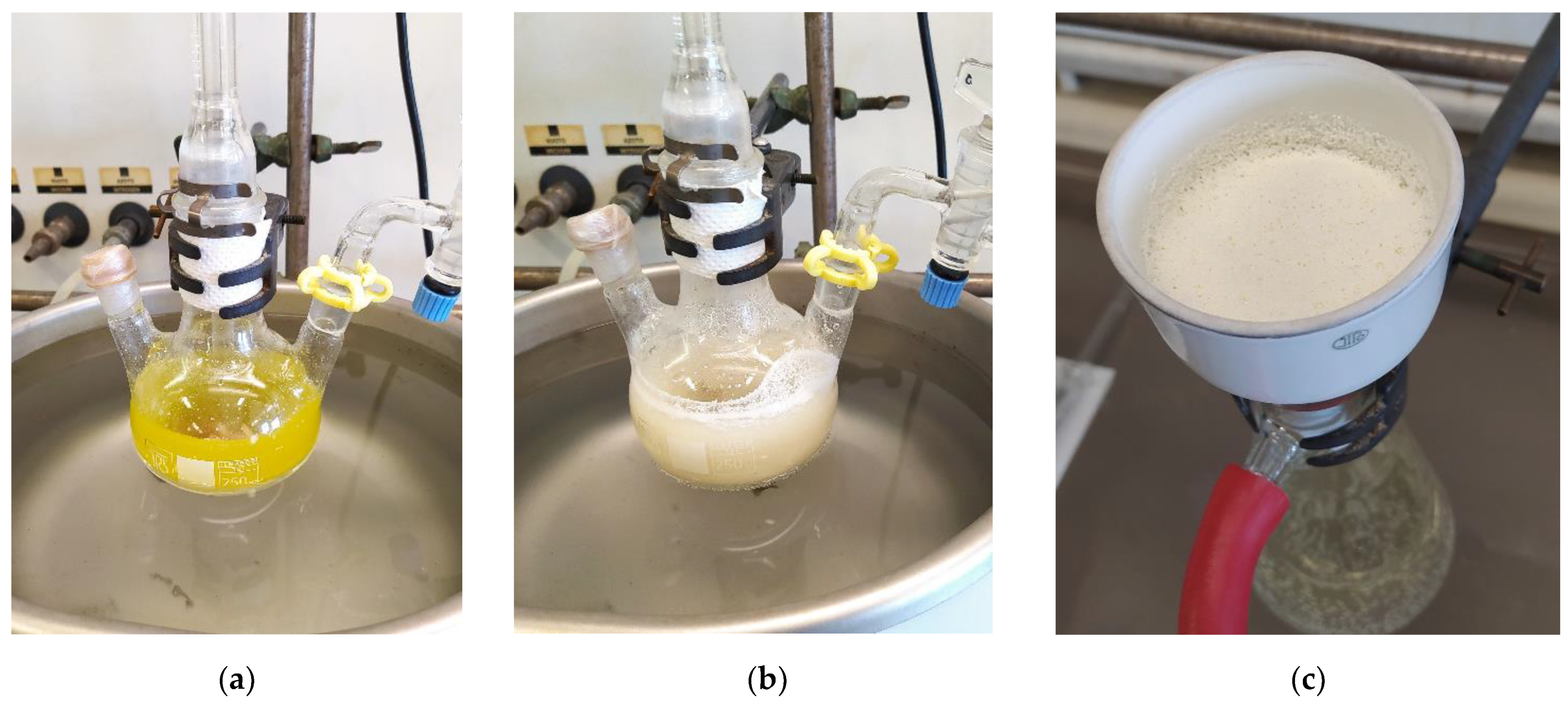
| Entry | OLH 1 | Enzyme Stabilizers 2 | Yield (%) 3 |
|---|---|---|---|
| 1 | Recombinant E. coli whole cell | Glycerol | 95 |
| 2 | Recombinant E. coli lysate | Glycerol | 2 |
| 3 | Recombinant E. coli lysate | Sorbitol | 0 |
| 4 | OLH purified and dialyzed | Glycerol | 0 |
| 5 | OLH purified + imidazol buffer | Glycerol | 0 |
| 6 | OLH purified and dialyzed + FAD (0.2 mM) | Glycerol | <1 |
| Entry 1 | OLH 2 | GDH 3 | FAD | NADP+ | NAD+ | Flavin Oxidoreductase 4 | Yield (%) 5 |
|---|---|---|---|---|---|---|---|
| 1 | Purified | Purified | 0.3 mM | 2 mg/mL | - | - (Y) | 0 |
| 2 | Purified | Purified | 0.3 mM | 2 mg/mL | - | B. subtilis lysate (C) | 95 |
| 3 | Purified | Purified | 0.3 mM | - | 2 mg/mL | B. subtilis lysate (C) | 96 |
| 4 | Purified | Recombinant E. coli lysate | 0.3 mM | 2 mg/mL | - | E. coli lysate (C) | 98 |
| 5 | - | Recombinant E. coli lysate | 0.3 mM | 2 mg/mL | - | E. coli lysate (C) | 0 |
| 6 | Purified | Recombinant E. coli lysate | - | 2 mg/mL | - | E. coli lysate (C) | 16 |
| 7 | Purified | Purified | - | 2 mg/mL | - | - (C) | 0 |
| Entry 1 | OLH 2 | FAD | Reducing Agent 3 | Fatty Acid | Yield (%) 4 |
|---|---|---|---|---|---|
| 1 | Purified | - | Cys (5 g/L) | Oleic acid (6 g/L) | 0 |
| 2 | Purified | - | DTT (5 g/L) | Oleic acid (6 g/L) | 0 |
| 3 | Purified | - | Cys (5 g/L) + Thiogl. (2 g/L) | Oleic acid (6 g/L) | 0 |
| 4 | Purified | - | Cys (5 g/L) + HOCH2SO2Na·2H2O (2 g/L) | Oleic acid (6 g/L) | 0 |
| 5 | Purified | - | Ti3+ (5 mM) | Oleic acid (6 g/L) | <1 |
| 6 | Purified | 0.15 mM | Ti3+ (5 mM) | Oleic acid (6 g/L) | 96 |
| 7 | Purified | 0.15 mM | Ti3+ (5 mM) | Oleic acid (9 g/L) | 91 |
| 8 | - | 0.15 mM | Ti3+ (5 mM) | Oleic acid (6 g/L) | 0 |
| 9 | Purified | 0.15 mM | - | Oleic acid (3 g/L) | <1 |
| 10 | Purified | 0.15 mM | Ti3+ (5 mM) | Linoleic acid (6 g/L) | 58 |
| 11 | Purified | 0.15 mM | Ti3+ (5 mM) | Linolenic acid (6 g/L) | 31 |
Publisher’s Note: MDPI stays neutral with regard to jurisdictional claims in published maps and institutional affiliations. |
© 2021 by the authors. Licensee MDPI, Basel, Switzerland. This article is an open access article distributed under the terms and conditions of the Creative Commons Attribution (CC BY) license (https://creativecommons.org/licenses/by/4.0/).
Share and Cite
Serra, S.; De Simeis, D.; Marzorati, S.; Valentino, M. Oleate Hydratase from Lactobacillus rhamnosus ATCC 53103: A FADH2-Dependent Enzyme with Remarkable Industrial Potential. Catalysts 2021, 11, 1051. https://doi.org/10.3390/catal11091051
Serra S, De Simeis D, Marzorati S, Valentino M. Oleate Hydratase from Lactobacillus rhamnosus ATCC 53103: A FADH2-Dependent Enzyme with Remarkable Industrial Potential. Catalysts. 2021; 11(9):1051. https://doi.org/10.3390/catal11091051
Chicago/Turabian StyleSerra, Stefano, Davide De Simeis, Stefano Marzorati, and Mattia Valentino. 2021. "Oleate Hydratase from Lactobacillus rhamnosus ATCC 53103: A FADH2-Dependent Enzyme with Remarkable Industrial Potential" Catalysts 11, no. 9: 1051. https://doi.org/10.3390/catal11091051
APA StyleSerra, S., De Simeis, D., Marzorati, S., & Valentino, M. (2021). Oleate Hydratase from Lactobacillus rhamnosus ATCC 53103: A FADH2-Dependent Enzyme with Remarkable Industrial Potential. Catalysts, 11(9), 1051. https://doi.org/10.3390/catal11091051






